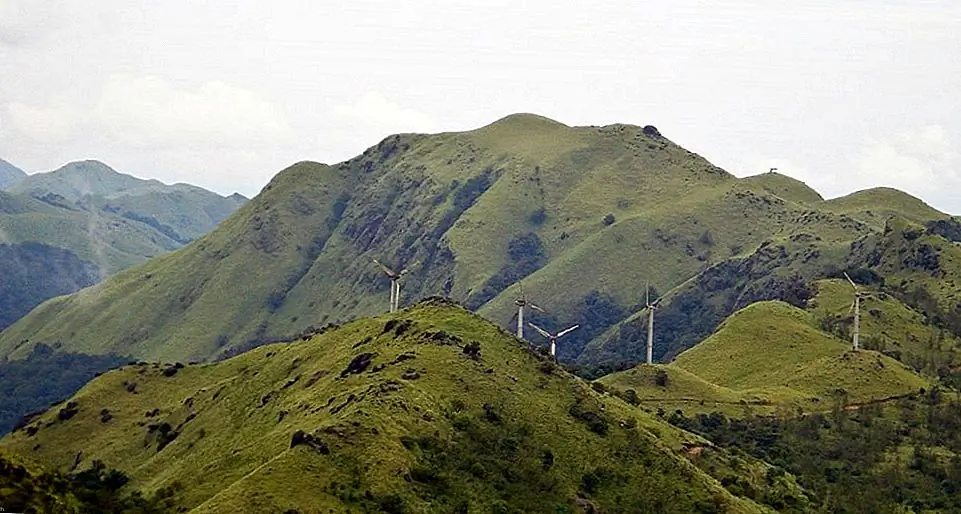“The waterfall is just a little further,” the forest ranger reported enthusiastically. I was panting with exhaustion, as the trail – which had been largely comfortable until then – had become significantly steeper. I stopped and looked around: a clear stream emerged from a narrow valley and rushed away through moss-laden boulders. In the backdrop of this verdant riverscape rose a range of lofty hills of the Western Ghats, their peaks obscured by a mass of dense, rain-bearing clouds. Somewhere up there, another half-day trek, was our destination – the Brahmagiri Peak. We continued walking and as we rounded a bend I was surprised by a deafening roar. Before I could even catch the first glimpse of the magnificent Irpu Waterfall, I was drenched in spray. As I wiped my glasses, a flash of brilliant emerald caught my eye. On the damp field of moss sat a beautiful, ethereal blue-green butterfly, glistening with a metallic sheen. It was the most beautiful butterfly I had ever seen. I later discovered that it was the Malabar striped peacock, a species endemic to the Western Ghats.
We were hiking in the monsoons, perhaps an uncomfortable time to get up, but as our guide impressed us, the beauty of the waterfall was best enjoyed in the rain. In any case, the Western Ghats are undeniably charming in the monsoons. Heavy clouds hang moodily over the valleys, dissipating in frequent showers. Several streams turn into violent torrents and crash down the hills in a swirling foam and spray truck. This abundant rainfall is considered to be one of the main reasons why an exceptional diversity of life is found in the hills of Western Ghats, and this biodiversity was something I could easily appreciate during the climb to Brahmagiri Peak. The butterfly was indeed a good omen. Would I be lucky enough to see more rare species? It didn’t really matter because the scenery itself made my trip worth it.
Read also: Brahmagiri-The Ridge Across Forever
The guard warned us about leeches as he picked a piece of polyethylene from the ground. He put it in his pocket and said, “Most people prefer the dry season for trekking. There are too many leeches in the rains. His warning came a little too late – that’s when I noticed the telltale trickle of blood between my toes. Leeches cannot be avoided in the Western Ghats, but one can take solace in the fact that their bites do not hurt. As we passed through one of the shola forests on the hills, the trail almost disappeared into the undergrowth beneath our feet. These forests occur in a mosaic of rainforest patches interspersed with rolling grasslands, and the juxtaposition of forests and grass gives the landscape a captivating beauty.
The gnarled tree trunks around us were thick with a layer of moss and lichens, under which orchids grew. The darkness resounded with a chorus of crickets and cricket-like calls from tree frogs. In the canopy above me, a hill myna was screaming and I tried in vain to get a glimpse of the bird. It is true what everyone says – one can hear the sound of life in the shola forest, but it is difficult to see its source.
Without warning the rain started coming down. Large drops fell hard on the leaves with a loud splash that mimicked a waterfall. And then, above the roar of the rain, we heard a singing flute that had an astonishingly human quality. Behind a curtain of ferns on a rock lay a blue bird with iridescent spots on its shoulders, giving a live performance. It was the unmistakable Malabar whistling thrush, aptly known as the ‘whistling schoolboy’. Another endemic species to add to my list. The pull towards Brahmagiri was full of such moments – the beauty of nature unfolding around us, embellished by the freshness and greenness of rain. Some people have seen elephants and leopards during this trek! The ‘schoolboy’ I saw was much smaller in size, but for me the sighting was no less exciting.
Quick Facts
Stands: Karnataka
Place:Near the Karnataka-Kerala border in Kodagu District, the coffee capital of India, in the Western Ghats.
Distance: 250 km SW of Bengaluru
Travel time: By road 5 hours, by rail 3 hours + 3 hours
Read also:





